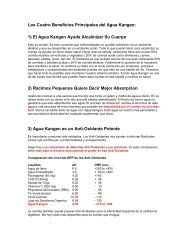ACID-ALKALINE BALANCE: ROLE IN CHRONIC ... - My Kangen Tools
ACID-ALKALINE BALANCE: ROLE IN CHRONIC ... - My Kangen Tools
ACID-ALKALINE BALANCE: ROLE IN CHRONIC ... - My Kangen Tools
Create successful ePaper yourself
Turn your PDF publications into a flip-book with our unique Google optimized e-Paper software.
to suppress single-strand breakage of DNA induced by reactive oxygen<br />
species produced by H2O2/Cu (II) and HQ/Cu (II) systems. The<br />
enhancement of superoxide anion radical dismutation activity can be<br />
explained by changes in the ionic product of water in the reduced<br />
water.<br />
PMID: 14871602 [PubMed - in process]<br />
The following information is sourced from various peer reviewed literature as well as various<br />
Internet sites. This information is for educational purposes only and is not meant to cure or<br />
treat any disease or illness. Consult your doctor for specialised medical advice.<br />
Comparison of electrolyzed oxidizing water with various<br />
antimicrobial interventions to reduce Salmonella species on<br />
poultry.<br />
Use of Acid Water to reduce Foodborne Pathogens<br />
Poult Sci.<br />
2002 Oct;81(10):1598-605.<br />
Fabrizio KA, Sharma RR, Demirci A, Cutter CN.<br />
Department of Food Science, The Pennsylvania State University, University Park 16802, USA.<br />
Foodborne pathogens in cell suspensions or attached to surfaces can<br />
be reduced by electrolyzed oxidizing (EO) water; however, the use of<br />
EO water against pathogens associated with poultry has not been<br />
explored.<br />
In this study, acidic EO water [EO-A; pH 2.6, chlorine (CL) 20 to 50<br />
ppm, and oxidation-reduction potential (ORP) of 1,150 mV], basic EO<br />
water (EO-B; pH 11.6, ORP of -795 mV), CL, ozonated water (OZ),<br />
acetic acid (AA), or trisodium phosphate (TSP) was applied to broiler<br />
carcasses inoculated with Salmonella Typhimurium (ST) and<br />
submerged (4 C, 45 min), spray-washed (85 psi, 25 C, 15 s), or<br />
subjected to multiple interventions (EO-B spray, immersed in EO-A;<br />
AA or TSP spray, immersed in CL). Remaining bacterial populations<br />
were determined and compared at Day 0 and 7 of aerobic, refrigerated<br />
storage. At Day 0, submersion in TSP and AA reduced ST 1.41 log10,<br />
whereas EO-A water reduced ST approximately 0.86 log10. After 7 d<br />
of storage, EO-A water, OZ, TSP, and AA reduced ST, with detection<br />
only after selective enrichment. Spray-washing treatments with any of<br />
the compounds did not reduce ST at Day 0. After 7 d of storage, TSP,<br />
AA, and EO-A water reduced ST 2.17, 2.31, and 1.06 log10,<br />
respectively. ST was reduced 2.11 log10 immediately following the<br />
multiple interventions, 3.81 log10 after 7 d of storage. Although<br />
effective against ST, TSP and AA are costly and adversely affect the<br />
environment.<br />
This study demonstrates that EO water can reduce ST on poultry<br />
surfaces following extended refrigerated storage.



